The Double Comma Club
Episodes

Friday Nov 04, 2022
Housing Today Comes Down to These Things
Friday Nov 04, 2022
Friday Nov 04, 2022
As we continue to see FED rate increases to slow the economy, we are starting to feel the fear, and it all comes with a price. The price is fear, instability, and job loss. Which in turn creates volatility as markets react to economic reports without the stabilization of a Federal Reserve buying mortgaged-backed securities and treasuries. But, I want to break housing down into four buckets this month: supply, demand, affordability, and credit availability.
The housing sector is strong, well-funded and able to withstand short-term volatility. While critics continue to generate fear around instability, crisis, bubbles, foreclosures, and more, our job as real estate professionals is simply to support reality with facts. Listen to your DMAR November Denver Real Estate Market Update!
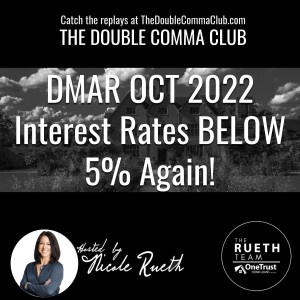
Friday Oct 07, 2022
Interest Rates are Below 5% Again
Friday Oct 07, 2022
Friday Oct 07, 2022
After July's momentary celebration of 5% interest rates, August ended the month at six, then September just finished having crossed 7%. Only a few months ago, six and a quarter seemed like the absolute ceiling as the US continued its strong stance against the slowing global economy, but that didn't last. We saw European economies bear the brunt of Russia's war on Ukraine. Japan struggling with lower global demand for its manufactured goods and China's economic troubles thanks to its zero Covid policy. All of these strengthen the dollar while creating credible volatility for our mortgage bonds. The fight here in the United States is the fight against inflation. For the last few years, we've seen too many dollars chasing too few goods, pushing the price of those goods up as demand spiked.
The Federal Reserve's job now is to constrain the dollar spent. Think about this. 28% of all goods purchased are done with a credit card that doesn't even include car loans, home loans, or business loans. Buying on credit creates money, future money pulled forward, giving you access to a product or service today for payment in the future. For the Fed to control spending, they have to make the cost of borrowing higher, so it creates more pain. At the same time, the benefit of savings has also gone up as the Fed raised its Fed rate or overnight rate. So goes the one-year treasury. The safest of all investments is backed by the federal government. This rate is 4.01% today, which is significantly higher than the long-term average of 2.85% and will increase further after November 2nd.
Listen to the rest of this summary.

Wednesday Sep 07, 2022
DMAR Sept 2022 Homeowners Have the Upperhand
Wednesday Sep 07, 2022
Wednesday Sep 07, 2022
Historically the best forecasters have been able to consistently recognize that we are in a recession. Once we are actually in one to preemptively determine its onset has riddled economists for decades. Yet, an AR is Lawrence soon called a recession in August when he said, "In terms of economic impact, we are surely in a housing recession."
A recession is defined by Oxford is a period of temporary economic decline during which trade and industrial activity are reduced. This is generally defined by a fall in GDP for two consecutive quarters. This definition has then been further clarified by the National Bureau of Economic Research to a significant decline in economic activity.
Active listings while almost double last year, they've started their seasonal downward slope towards December by dropping 5.7% month over month, new listings peak a few months early this year dropping another 18.5%.
This month, median and average home prices have also seen a steady slowdown from well over 20% earlier this year to 6.8% average and 8.5% median year-over-year increase in August.
Days in the MLS grew from six median days to 11 and close to list dropped to 99.41%.
Year-to-date new listings and home sales are behind 2018 and 2019 by approximately 8%, showing that both sellers and buyers are moving slower, not just than the pandemic frenzy but also the pre-pandemic seasonality.
The slowing has come primarily from the rapid rise of mortgage interest rates increasing the monthly cost to purchase August saw more than its share of volatility.
Think of a child you've been giving Tootsie Rolls to for over an hour to keep him quiet during your very important meeting. How justified is the pain that child ensues as he works his way off the sugar rush? Justified or not, inflation must be tamed, and it will cause pain, but that pain is relative. It's relative to the specific household and the specific industry.
ADP's August employment report also showed pay increases nationwide for those who stayed on their job by 7.6%, and up for 16.1%; for those who got new jobs, consumer sentiment even increased this month by 13% due to a 59% surge in the year ahead. Outlook for the economy? Consumers are feeling good about inflation, getting tamed jobs secured and a quick economic recovery. All of this comes back to defining a housing recession.
Lawrence said it best, "It is a difficult market for those selling homes and for home builders. But homeowners continue to accumulate housing wealth from rising home prices."
I will concede through the definition of a housing recession by slowing the sales cycle, but with builders, not building, homeowners locked into rates not likely to be seen again, and baby boomers aging in place, inventory will not right size for a very long time. If ever this lack of inventory will keep home prices increasing over 27 trillion in homeowner, equity will keep homeowners from having to sell at a loss wage increases will keep buyers able to purchase.
This is Nicole Ruth with The Rueth Team, now the proud and excited newest member of the OneTrust Home Loans, family. It's my pleasure to keep you updated.
Listen to the full 9-minute episode to get more detailed comparisons and statistics.
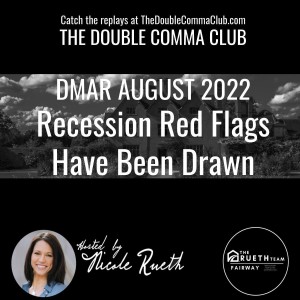
Monday Aug 08, 2022
DMAR August 2022 Recession Red Flags Have Been Drawn
Monday Aug 08, 2022
Monday Aug 08, 2022
A recession is always coming, it’s just a matter of time. It’s purely the nature of a cyclical economy. “Are we in a recession” searches continue to hit record levels on Google, and talk of a housing recession has some counting on the bubble to burst. With more inventory and all other numbers lower across the board, it’s starting to look like a recession, or, maybe it’s just the slowdown we’ve all been hoping for.
A recession does not equal a housing bubble. While there will be layoffs, slowed production, and a softening in consumer spending, Americans are coming into this recession with $2 trillion in savings and twice the home equity there was in 2006. Colorado is also protected by having 38% of homes owned free and clear, only 1.7% of mortgaged homes delinquent, and a current foreclosure rate of 0.1%. If home prices continue to slow, as I expect they could during the second half of 2022, recent buyers might lose a little value, some homeowners might even need to sell quickly, but most will simply not sell. Knowing that as rates drop, as they consistently do during recessions, pent-up demand will reengage with our limited supply, forcing multiple bids and yet again higher prices.
Institutions, first-time home buyers, and those who have been waiting will all be ready to buy on these dips. And since we have not yet achieved an inventory level that could comfortably sustain a surge in demand, the thought of a housing bubble eludes me.
Nicole Rueth, SVPThe Rueth Team Powered by OneTrust Home Loans750 W Hampden Avenue, Suite 500 Englewood, CO 80110303-214-6393www.TheRuethTeam.comConnect on social media: Follow me on FB: https://www.facebook.com/theruethteam/Twitter: https://twitter.com/nicoleruethLinkedin: https://www.linkedin.com/company/theruethteam YouTube Channel: https://www.youtube.com/channel/UCPMdb94tUNMMsUTgdWRMDKwNicole Rueth (NMLS 239840) is licensed to practice on behalf of OneTrust Home Loans (NMLS 46375) in the states listed below. For full compliance verbiage, visit theruethteam.com/compliance/.AZ, CA, CO, FL, ID, IL, IN, KS, MI, MN, MS, MO, MT, NE, NM, NC, OK, OR, TN, TX, UT, VA, WA, WI, WY.
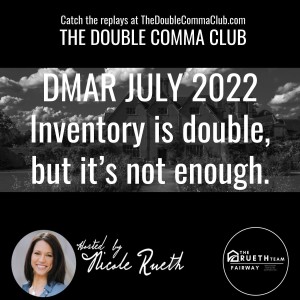
Friday Jul 08, 2022
DMAR July 2022 - Inventory is double but it is not enough
Friday Jul 08, 2022
Friday Jul 08, 2022
Inventory exceeded demand in June for the first time since the same month in 2020. Spiking 94% year-over-year and 66% month-over-month. Price reductions, according to Redfin, increased to 40% of homes on the market in Denver. If the story ended there, it might concern me. Sellers flooding the market giving homes away at discounted prices. But the story is much different than that. June ended the first half of a transitional 2022 and it did so with a bang. Cryptocurrency is down 60%; the stock market had its worst first half of a year since 1970, inflation hit a 41-year high and housing.. well, so far this year, housing is up 16.5%. 2022 year-to-date median price growth is only 1% lower than we experienced during the first half of 2021.
With all this inventory, though, buyers and sellers “feel” like it shifted to a buyers’ market. Get the full story in this episode of The Double Comma Club, "Inventory is double last year, but it is not enough."
Nicole Rueth, SVPThe Rueth Team750 W Hampden Avenue, Suite 500 Englewood, CO 80110303-214-6393www.TheRuethTeam.comConnect on social media: Follow me on FB: https://www.facebook.com/theruethteam/Twitter: https://twitter.com/nicoleruethLinkedin: https://www.linkedin.com/company/the-rueth-team-fairway-independent-mortgage/YouTube Channel: https://www.youtube.com/channel/UCPMdb94tUNMMsUTgdWRMDKwNicole Rueth (NMLS 239840) is licensed to practice on behalf of OneTrust Home Loans (NMLS 46375) in the states listed below. For full compliance verbiage, visit theruethteam.com/compliance/.AZ, CA, CO, FL, ID, IL, IN, KS, MI, MN, MS, MO, MT, NE, NM, NC, OK, OR, TN, TX, UT, VA, WA, WI, WY.
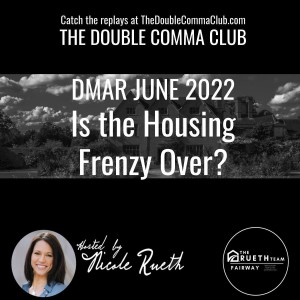
Friday Jun 03, 2022
DMAR June 2022 - Is the housing frenzy over?
Friday Jun 03, 2022
Friday Jun 03, 2022
Months of Inventory for May landed at 0.67% or 20 days. A balanced market, when supply equals demand, is defined by 6 months of inventory. Yet, on the street, real estate agents and buyers “feel” like we are headed towards a balanced market. Close to List came in at 105.33% telling us buyers are still paying more than asking on average. If you look at over $1 million dollar homes, those went for 107.12% close to list. And median days on market were still a hot 4 days.
Yet some listings had few to no showings their first weekend on market and the median closed price actually dropped 0.24%. 197 more homes sold and 631 more homes went under contract than last month, while 72 fewer homes came on the market to choose from.
Given these numbers it’s obvious that the active listings count pulled on the last day of May, on a Tuesday, would jump 14% from last month and 76% from last year giving buyers 3,652 homes to choose from. Right?
Buyer demand as measured by the United States MBA Purchase Index dropped 12.3% during the month of May. Mortgage purchase applications softened as interest rates hit an average of 5.62% for a 30-year fixed mortgage on May 7th per the Mortgage News Daily survey. Application numbers remained muted even while rates dropped 0.5% during the 2nd half of May. With all the graduations and holidays, did buyers not notice?
Buyers and sellers alike are trying to figure out how to time this market. A market in transition is sending mixed messages. Inventory is still painfully low. Closing 5,445 units last month means we need 32,670 homes for sale for a balanced market, an unrealistic number given Denver’s propensity for being a sellers-market. I’d be thrilled with even the 10,527 average active listings we’ve seen in May from 2008 through 2022. There is a third of that today. But rising inventory will be the tell-tale of an easing market. And we would expect to see rising inventory given consumer inflation of 8.3% and mortgage rates above 5% should cool buyer demand.
Mortgage rates are expected to stay above 5% through 2022 as the Federal Reserve kicks off quantitative tightening on the 1st of June and plans on raising the Fed Rate by 0.5% in June and again in July. We will know more as the Fed releases their Dot Plot Map at their June meeting; giving us clues as to where they see the Fed Rate going for the rest of 2022 as well as 2023 and 2024. Many economists expect rates to stay where they are or even go a little higher as inflation continues to prove less transitory and weighted more on longer-lasting wages, housing, and the geopolitical events happening around us. These higher borrowing rates on top of our 18.42% year-to-date higher median closed prices could and should yield us longer days on market, higher active inventory counts, and softer month-over-month price growth as buyers become more decerning and slower to pull the trigger.
Sellers will need to adjust their strategies to continue to attract more buyers. 8.3% of closed transactions this May reduced their asking price prior to receiving an offer. This compares to 6.9% in May of 2021. Those properties that reduced their price spent a painful average of 28.4 days in the MLS compared to 7 days for those with no price reductions. Sellers with homes on busy streets, odd layouts, or deferred maintenance might have missed their winning opportunity. But for the rest of the sellers, pricing right and staging well will continue to reap rewards given our current months of inventory and close-to-list.
Because buyers are still buying and willing to pay a premium.
Despite consumer confidence dipping 2.2 points, retail sales are up 0.9% month-over-month and 8.2% year-over-year. Luxury sales, travel, and housing are all winners in the eyes of today’s buyers. As the number one hedge against inflation, housing will continue to remain strong even as we move inches towards a balanced market. Because while the wealthy are spending $195 million on Andy Warhol prints of Marilyn Monroe and $143 million for 1955 vintage Mercedes Benz as hedges, the rest of us can count on a good home continuing to grow at a good pace providing stability and financial security as our hedge against inflation.
Until next time, that’s a wrap for this month’s Market Trends update. It’s my pleasure to keep you updated,
Nicole Rueth of The Rueth Team of Fairway Mortgage

Friday May 06, 2022
Appreciation is dropping, will home values follow?
Friday May 06, 2022
Friday May 06, 2022
Did we peak in February? Both average and median price growth slowed in April. Looking back, month-over-month median price growth started out flat in January, yet low inventory and strong pending home sales provided a strong close-to-list of 102%. (meaning the average buyer was paying 2% over asking) In February, prices rose a strong 6.5% in one month, as active listings stayed depressingly low, pushing close-to-list up to 105%.
March saw a swell of much-needed inventory if you can call 6,020 newly listed homes a swell, giving buyers a few more choices but no extra days. Days on market stayed at 4; while the close-to-list increased to 106.5% even while median home prices softened to a 4.8% month over month increase. April’s data reflected a slowing median home price growth again as it increased only 3.81% from last month with almost 7,000 homes hitting the market, yet the close-to-list continued to increase to 107%.
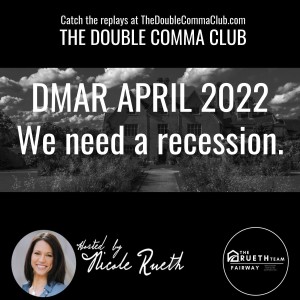
Monday Apr 04, 2022
DMAR April 2022 - We need a recession.
Monday Apr 04, 2022
Monday Apr 04, 2022
A recession is exactly what we need right now. And it's good for housing. So what am I talking about? The two in tenure treasury yield had a small 0.05 spread as March ended. This is on the verge of inverting, which is a high validity recession indicator of five of the last six recessions that were all proceeded by an inversion. However, today we also have incredibly strong labor market. The unemployment number just came out at 3.6%, which is a post-pandemic low. In fact, unemployment has only been lower than 3.6%, three times since 1950 non-farm payroll saw robust 431,000 jobs added, which is alongside 11.3 million job.
If you remember an inventory in 2018, when rates pushed above 5%, 1,827, new listings came on the market during March that's a 44% month of a month increase, but more than half of those new listings were scooped up as pendings increased by 1039 and closed homes increased by 941.
While more inventory might give buyers a little more breathing room, they are not giving up with more inventory. We have more sales. This additional inventory is partially due to seasonality. I mean, some of it is investors taking their winnings off the table and others are looking at this intense demand and talks of a bubble and wanting to play the timing game. I think as prices rise, high prices are a bit of a cure for high prices. The appreciation much like inflation will slow down, but talks of a bubble assume high prices themselves are the tipping point and they aren't homeownership, equity of 69.2%, a vacancy rate of 1.6% and a high birth rate. 30 to 33 years ago, all starve off the bubble talks 75,000 annual equity gain for an average Colorado. In addition to a 0.01% Colorado foreclosure rate, and a 1.9% 30 day rate tells me that struggling homeowners don't have to sell at a discount just at market,

Friday Mar 04, 2022
DMAR March 2022 - Real Estate is Globally Affected
Friday Mar 04, 2022
Friday Mar 04, 2022
Denver appreciated 19.1% over the last year alone. 60% of all homes are selling over asking prices. The Denver Real Estate Market came in strong and fast in 2022. That fact, coupled with Russia's global actions is going to have an impact on our housing market more than just the liquidity we see circulating. It will continue to put upward pressure on a rising inflationary market, increasing the cost of everything. 2022 housing buzz words will include terms like global impact, market velocity, inventory shortage, shifting interest rates, insatiable buyer demand, rising inflation, and affordability. So, what are mortgage rates doing and where do we go from here?

Friday Feb 04, 2022
DMAR Feb 2022 - Will Mortgage Rates Break 4% in 2022?
Friday Feb 04, 2022
Friday Feb 04, 2022
Interest rates have been on a downward trend since 1981 when the 30-year fixed rate hit 18.5%. Just three years ago they were almost 5%. Now, news cycles are headlining rates jumping from 2.625 to 3.25% in 2021 and climbing from 3.25 to 3.5% in 2022.
If you bought your first home in the 80’s, 90’s, or even 2000’s, you're laughing out loud when the words “jumped” and “climbing” are used with rates in the low 3’s.
The low rates in 2020 and 2021 both propelled and offset the insanity which was extreme housing demand with a limited supply. I don’t have to remind you of what happened, but it does beg the question…
Where do we go from here?